
Frank Lloyd Wright was born on June 8,
1867 [ - 109 ]
in Richland Center, Wisconsin. He spent a few semesters in the Engineering
School at the University of Wisconsin before leaving for Chicago in
1887. At the age of twenty, he was hired as an apprentice in the office
of J. Lyman Silsbee who designed All Souls' Unitarian Church where
Wright's uncle was minister. The young architect's first work was
nominally a Silsbee commission --the Hillside Home School built for
his aunts in 1888 near Spring Green, Wisconsin.
While construction was underway on the Hillside Home School, Wright went to work for the Chicago firm of Dankmar Adler and Louis Sullivan, working as a draftsman on the Auditorium Building, which, at the time of completion in 1890, was the largest building in Chicago. He remained with that firm until 1893, during which time he absorbed Sullivan's influence and designed several houses, including one for himself in Oak Park, Illinois that was constructed with Sullivan's financial assistance.
"Moonlighting" on his own commissions led to a break with Sullivan in 1893, and Wright set up a separate practice. His first commissions were primarily for the design of private homes in the more affluent suburbs of Chicago and include the W. H. Winslow house of 1893-94 in River Forest, Illinois --considered by Wright to be his "first." Unfortunately, many of the buildings he designed around the turn of the century have not survived.
| The Prairie Style |
Through the turn of the century, Wright's distinctively personal style was evolving, and his work in these years foreshadowed his so-called "prairie style," a term deriving from the publication in 1901 of "A Home in a Prairie Town" which he designed for the Ladies' Home Journal.
Prairie houses were characterized by low, horizontal lines that were meant to blend with the flat landscape around them. Typically, these structures were built around a central chimney, consisted of broad open spaces instead of strictly defined rooms, and deliberately blurred the distinction between interior space and the surrounding terrain. Wright acclaimed "the new reality that is space instead of matter" and, about architectural interiors, said that the "reality of a building is not the container but the space within." The W.W. Willits house, built in Highland Park, Illinois in 1902, was the first house that embodied all the elements of the prairie style. His masterpiece of the prairie style is the Robie House, built in Chicago in 1909.
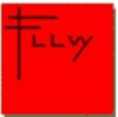
Wright did not aspire simply to design a house, but to create a complete environment, and he often dictated the details of the interior. He designed stained glass, fabrics, furniture, carpet and the accessories of the house. Legend has it that, in at least one case, he even designed the gowns of his client's wife.The controlling factor was seldom the wishes of the individual client, but Wright's belief that buildings stongly influence the people who inhabit them. He believed that "the architect is a molder of men, whether or not he consciously assumes the responsibility."
| Non-Resident Works, 1900 - 1920 |
Wright's basic philosophy of architecture was stated primarily through the house form, and he had few major commissions for public buildings, office buildings or skyscrapers in the early years. The Larkin Administration Building in Buffalo, New York (1903) was his only large-scale structure prior to the Midway Gardens in Chicago (1913) and the Imperial Hotel in Tokyo ( 1915-16). None of these buildings is standing today.
Nevertheless, two of Wright's non-residential works of this period are among the most widely admired and imitated architectural works of the century. The Larkin Administration Building in Buffalo and Unity Church in Oak Park, Illinois (1904) are considered highly important works, and, with the prairie houses, earned him acclaim in Europe where exhibitions of his work hastened the demise of Art Nouveau and stimulated younger architects to seek a new direction.
| The Twenties |
In the decade following World War I, Wright's level of production declined. Although he worked on a series of projects, some of which later provided the basis for executed buildings, the number of buildings actually constructed during this period was minimal when compared to the work of the preceding years.
In the 1920's, Wright explored the use of poured concrete and abstract sculptural ornamentation in residential construction. He developed a type of construction using precast "textile" concrete blocks which were bound together by steel rods and poured concrete. This "textile-block" construction method found its best expression in a series of four houses built in the hills around Los Angeles, California.
| The Thirties |
Despite the Depression, Wright began to secure important commissions and to make a contribution in the field of low-cost housing. During the early 1930's, when commissions were few, he turned to writing and lecturing for income and developed his plan for Broadacre City, an integrated and self-sufficient community of detached housing with built-in industries. The plan for Broadacre City was never executed, but it did enable Wright to advance his ideas on city planning and to develop the concept of the "garden town" with detached houses within natural surroundings.
The small Malcolm E. Willey House, designed in 1933 and constructed the following year in Minneapolis, marked the beginning of what amounted to a second career for Wright. Modest in size, the Willey House was low and L-shaped with little ornamentation and represented a revolutionary change in domestic planning; i.e., the living room and dining room were completely unified in a single space, and the kitchen ("workspace") was only separated from the living area by a range of shelves. This house is said to be the "bridge" between the prairie houses and the Usonian houses, the first of which was erected in 1937 near Madison, Wisconsin. With the Usonian houses, Wright achieved his goal of providing a small, modestly priced and easily built house for the average middle-class family that possessed the aesthetic, organic and spatial characteristics of the prairie style house.
Wright's most important buildings constructed in the 1930's were Fallingwater (the Edgar J. Kaufmann House) at Bear Run, Pennsylvania and the Administration Building of the S.C. Johnson and Son Company in Racine, Wisconsin. Both were designed in 1935-36 and each makes bold use of concrete, but the two buildings are worlds apart in style and character. Combining features of the prairie houses and the California concrete block houses, Fallingwater has been described as "the apotheosis of the horizontal." Its cantilevered terraces soar dramatically over a natural waterfall, and the interior of the house blends seamlessly into the surrounding woods. The Johnson Building, resembling a "gigantic and beautiful machine," is based on the curve rather than the cantilever and turns inward upon itself, ignoring the existence of the outside world.
| The Forties |
As the decade of the forties began, Frank Lloyd Wright's practice began to grow. In 1940-41, the Museum of Modern Art held a retrospective exhibit where he received several awards and honors. During World War II, he was an outspoken pacifist and encouraged conscientious objector status for some of his apprentices, prompting the FBI to investigate whether he was obstructing the war effort. The war brought most construction to a standstill, and only a handful of Wright's designs were built between 1941 and 1945. Nevertheless, the Second World War interrupted Wright's career less than the First, and various projects initiated during the war years came to fruition soon after the war was over when construction actively resumed.
Though well into his seventies by now, Wright's work of this decade provides evidence of the continuing vitality of his powers of invention. In addition to rectangles, triangles, hexagons and octagons as the basis for residential floor plans, the circle and the helix appeared in his constructed work. The Jacobs House, designed in 1943, was the first of a series of houses that he built with curved plans. This "solar hemicycle" has a two-story living area that bends around a circular sunken garden court with the bedrooms opening off a balcony above. The other side of the the house is half buried in the hilltop, over which rises the walls. Circles and spirals were also used to spectacular effect in the S. C. Johnson Research Tower (1944), the Morris Gift Shop (1948), and the Guggenheim Museum which he was commissioned to design in 1943.
| The Fifties |
After the age of eighty, Frank Lloyd Wright was busier than he had ever been, outpacing members of the next two generations. He undertook projects all over the world, seldom declining a commission. At the same time, he became a media superstar who divided his time between the spotlight and the drawing board, and he could not give his work the attention it required. Many projects of his last decade have been criticized as vulgar and repetitive, inappropriate for the site, superficially developed, and far removed from the principles of organic architecture that characterized his earlier work.
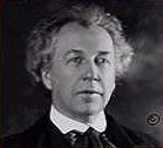
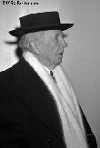
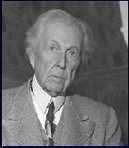
These criticisms notwithstanding, three of Wright's buildings from this decade were designated by the American Institute of Architects to be retained with fourteen others as examples of his architectural contribution to American culture --the Price Company Tower (1952), the Beth Sholom Synagogue (1954), and the Solomon R. Guggenheim Museum (1956). Many of the houses constructed during the fifties are notable for their siting, their materials and the geometrical themes of their design. His Usonian houses continued to exemplify affordable housing at its best.
Frank Lloyd Wright died on April 29, 1959 [ - 41 ], in Phoenix, Arizona. It is said that the project on his drawing board was a simple and affordable prefabricated concrete-block house.
![]()
|
Frank Lloyd Wright Residence (1889), Oak Park, Illinois. Wright constructed this house for himself and his family while working for the Chicago firm of Adler and Sullivan. Surfaced with wood shingles, it is the oldest extant building attributed wholly to Frank Lloyd Wright. |
 |
|
William H. Winslow House (1893), River Forest, Illinois The Winslow House was Wright's first independent commission after leaving the offices of Adler & Sullivan. Although the design is related to his work with Adler & Sullivan, some scholars think the Winslow House is his first "mature and original" building. |
 |
|
Ward W. Willets House (1901), Highland Park, Illinois The Willits House was the first house to embody all the classic elements of the Prairie style. Wright believed that the "space within the building was more important than its enclosure," and, with this house, he "opened the box." |
 |
|
Unity Church (1904), Oak Park, Illinois Unity Church was the "first significant American architectural statement in poured concrete." Wright's use of concrete was truly original, and Unity Church introduced this type of construction on a grand scale. |
 |
|
Frederick C. Robie House (1906), Chicago, Illinois The Robie House is considered Wright's masterpiece of the Prairie Style. Concealed, cantilevered steel beams create long, uninterrupted spaces that extend through windows onto porches and balconies, making walls disappear. |
 |
|
Hollyhock House (1917), Los Angeles, California The Aline Barnsdall "Hollyhock House", built about 1920, was named for its ornamental forms. The structure's monumentality and decorative elements evoke the architecture of the Maya which Wright admired as "mighty, primitive abstractions of man's nature." |
 |
|
Taliesin III (1925ff), Spring Green, Wisconsin The residence of Wright and his family and, later, the summer home of the Taliesin Fellowship, Taliesin rests on the brow of a hill overlooking a valley of the Wisconsin River. Taliesin has been described as the architect's "autobiography in wood and stone." |
 |
|
Fallingwater (1935), Bear Run, Ohiopyle, Pennsylvania In Fallingwater, which was built as a weekend retreat for Edgar J. Kaufmann, we see Wright's greatest expression of "organic architecture" --the union of the structure and the land upon which it is built. Fallingwater is considered Wright's masterwork. |
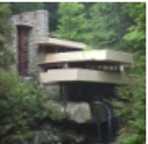 |
|
Honeycomb House (1936), Stanford, California This Usonian house built for Paul R. Hanna is planned on a hexagonal grid system with most walls meeting at 120-degree angles. Many interior walls are wood and can be easily assembled or disassembled for reconfiguration of living space. |
 |
|
S. C. Johnson Administration Building (1936), Racine, Wisconsin The "great workroom" of the Johnson Building has been called one of Wright's most "astonishing" spaces. The slender, hollow concrete columns are each capable of supporting six times the weight imposed on them. |
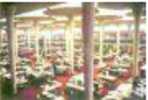 |
|
Taliesin West (1937ff), Scottsdale, Arizona Taliesin West, the winter home of Frank Lloyd Wright and the Taliesin Fellowship, appears to be part of the surrounding desert and mountain landscape. It is considered his "most dramatic assimilation of a building into a natural environment." |
 |
|
S. C. Johnson Research Tower (1944), Racine, Wisconsin Utilizing principles of design and construction that he initially conceptualized in the 1920's, the Research Tower was Wright's first cantilevered high-rise structure. Together with the earlier Administration Building, it is considered one of his greatest designs. |
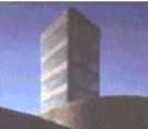 |
|
Unitarian Church (1947), Shorewood Hills, Wisconsin Wright believed that light and a "geometric type of space" allowed a structure "to achieve the sacred quality particular to worship." The plan and roof of this church are triangular and impart a reverential quality "without recourse to the steeple." |
 |
|
V. C. Morris Gift Shop (1948), San Francisco, California The fortress-like facade of the rectangular structure that surrounds this retail space protects the contents within, yet invites visitors to enter. The interior's circular mezzanine, spiral ramp and sensuous surfaces contrast dramatically with the simplicity of the exterior. |
 |
|
Price Company Tower (1952), Bartlesville, Oklahoma With the Price Tower, which rises 221 feet above the Oklahoma prairie, Wright expresses the organic ideal of the tree. A tap-root foundation solidly anchors the building to its site, and cantilevered floors hang like branches from the structural core of reinforced concrete. |
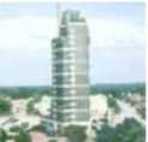 |
|
Beth Sholom Synagogue (1954), Elkins Park, Pennsylvania The glass walls of this tent-like structure are suspended from a steel tripod frame that allows the sanctuary to soar to a height of 100 feet without internal supports. Wright wanted to create the "kind of building in which people, on entering it, will feel as if they were resting in the hands of God." |
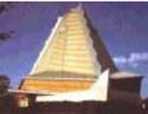 |
|
Solomon R. Guggenheim Museum (1956), New York, New York Of the museum's interior Wright said, "We are not building a cellular composition of compartments, but one where all is one great space on a continuous floor... no meeting of the eye with angular or abrupt changes of form..." It has been called one of the great architectural spaces of the 20th century. |
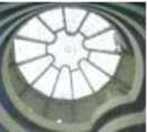 |
![]()
| Frank Lloyd Wright Quotations |
"Truth Against the
World"
"Freedom is from within"
"An expert is a man who has stopped thinking - he knows!"
"The truth is more important than the facts"
"There is nothing more uncommon than common sense"
"The heart is the chief feature of a functioning mind"
"An idea is salvation by imagination"
![]()
On Life
"The longer I live, the more beautiful
life becomes"
"Life always rides in strength to victory, not through internationalism ... but only through the direct responsibility of the individual"
"Give me the luxuries of life and I will willingly do without the necessities" - from An Autobiography, 1932.
![]()
On Marilyn
Monroe
"I think Ms. Monroe's architecture
is extremely good architecture"
![]()
On television
and other diversions
"I wouldn't mind seeing opera die.
Ever since I was a boy, I regarded opera as a ponderous anarchronism,
almost the equivalent of smoking"
"Television is bubble-gum for the mind" (This one has also been recorded as "Television is bubble-gum for the eyes")
"If it keeps up, man will atrophy all his limbs but the push-button finger"
![]()
On God and
Nature
"I believe in God, only I spell it Nature"
"Study nature, love nature, stay close to nature. It will never fail you"
"God is the great mysterious motivator of what we call nature, and it has been said often by philosophers, that nature is the will of God. And, I prefer to say that nature is the only body of God that we shall ever see. If we wish to know the truth concerning anything, we'll find it in the nature of that thing"
"Nature is my manifestation of God. I go to nature every day for inspiration in the day's work. I follow in building the principles which nature has used in its domain"
![]()
On pepper
"Don't eat it. It will kill you before your time. Avoid it"
![]()
On himself
"Early in life I had to choose between honest arrogance and hypocritical humility. I chose the former and have seen no reason to change"
"I feel coming on a strange disease -- humility"
![]()
On art and
architecture
"The mother art is architecture. Without an architecture of our own we have no soul of our own civilization"
"Organic architecture seeks superior sense of use and a finer sense of comforat, expressed in organic simplicity."
"Buildings, too, are children of Earth and Sun"
"Mechanization best serves mediocrity"
"No stream rises higher than its source. What ever man might build could never express or reflect more than he was. He could record neither more nor less than he had learned of life when the buildings were built."
"Classicism is a mask and does not reflect transition. How can such a static expression allow interpretation of human life as we know it? A fire house should not resemble a French Chateau, a bank a Greek temple and a university a Gothic Cathedral. All of the ism are imposition on life itself by way of previous education."
"Organic buildings are the strength and lightness of the spiders' spinning, buildings qualified by light, bred by native character to environment, married to the ground."
"A great architect is not made by way of a brain nearly so much as he is made by way of a cultivated, enriched heart."
"Less is only more where more is no good"
"Simplicity and repose are the qualities that measure the true value of any work of art"
"Respect the masterpiece. It is true reverence to man. There is no quality so great, none so much needed now."
"The room within is the great fact about the building"
"Form follows function-that has been misunderstood. Form and function should be one, joined in a spiritual union"
"Every great architect is -- necessarily -- a great poet. He must be a great original interpreter of his time, his day, his age"
The architect must be a prophet ... a prophet in the true sense of the term ... if he can't see at least ten years ahead don't call him an architect"
"An architect's most useful tools are an eraser at the drafting board, and a wrecking bar at the site"
"Consider everything in the nature of a hanging fixture a weakness, and naked radiators an abomination"
The following quote
could perhaps been woven into an introduction to Star Trek :
"Space. The continual becoming:
invisible fountain from which all rhythms flow and to which they must
pass. Beyond time or infinity"
"The space within becomes the reality of the building"
"Space is the breath of art"
"True ornament is not a matter of prettifying externals. It is organic with the structure it adorns, whether a person, a building, or a park. At its best it is an emphasis of structure, a realization in graceful terms of the nature of that which is ornamented"
"A doctor can bury his mistakes, but an architect can only advise his clients to plant vines"
![]()
On other
architects
"All I learned from Eliel Saarinen was how to make out an expense account" (said after he returned from a South American trip with Saarinen)"
"Well, now that he's finished one building, he'll go write four books about it" about Le Corbusier
"He exposes all the function on the top and puts the form below. It's as if you were to wear your entrails on top of your head." (about un-named well known architect of his day)
![]()
On government
and other institutions
"Toleration and liberty are the foundations of a great republic"
"A free America, democratic in the sense that our forefathers intended it to be, means just this: individual freedom for all, rich or poor, or else this system of government we call democracy is only an expedient to enslave man to the machine and make him like it."
"Democracy is the opposite of totalitarianism, communism, fascism, or mobocracy."
"Maybe we can show government how to operate better as a result of better architecture."
"We should have a system of economics that is structure, that is organic tools. We do not have it. We are all hanging by our eyebrows from skyhooks economically, just as we are architecturally"
"A vital difference between the professional man and a man of business is that money making to the professional man should, by virtue of his assumption, be incidental; to the business man it is primary. Money has its limitations; while it may buy quantity, there is something beyond it and that is quality"
"I believe totally in a Capitalist System, I only wish that someone would try it"
"Bureaucrats: they are dead at 30 and buried at 60. They are like custard pies; you can't nail them to a wall"
" Harvard takes perfectly good plums as students, and turns them into prunes"
![]()
On his buildings
and his own work
"I have been black and blue in some spot, somewhere, almost all my life from too intimate contacts with my own furniture." (1931)
"Why, I just shake the buildings out of my sleeves"
"The one on my board right now" - What FLW said when asked which of his buildings was the most beautiful
"Move the chair" - Wright's response to a client who phoned him to complain of rain leaking through the roof of the house onto the dining table.
![]()
On cities
"It [New York City] is a great monument
to the power of money and greed. . .a race for rent "
"Tip the world on its side and everything loose will land in Los Angeles"
"Eventually, I think Chicago will be the most beautiful great city left in the world" (1939)
"Abandon it." -- Frank Lloyd Wright, on being asked how he would go about improving Pittsburgh
![]()
More quotes
"'Think simple'" as my old
master used to say - meaning reduce the whole of its parts into the
simplest terms, getting back to first principles."
"Get the habit of analysis- analysis will in time enable synthesis to become your habit of mind."
![]()
Other relevant
quotes (not by Frank Lloyd Wright)
"If builders built buildings the
way programmers wrote programs, the first woodpecker would destroy
civilization" (Weinberg's Law)
"There are two things wrong with a Frank Lloyd Wright house. People will hardly let you get one built and will hardly let you live in it when it's done." - client Gregor Affleck

FLW REFERENCES
-
http://architecture.about.com/mbody.htm
-
http://home.att.net/~taliesin/index.html
-
http://home.columbus.rr.com/mfreeman/flw.htm
-
http://lcweb.loc.gov/exhibits/flw/
-
http://lcweb.loc.gov/exhibits/flw/flw.html
-
http://palm.conncoll.edu/fllw/
-
http://www.adelaide.net.au/~jpolias/FLW/
-
http://www.bc.edu/bc_org/avp/cas/fnart/fa267/FLW.html
-
http://www.cypgrp.com/flw/
-
http://www.delmars.com/wright/flwright.htm
-
http://www.franklloydwright.org/
-
http://www.geocities.com/CapitolHill/2317/flwbuild.html
-
http://www.greatbuildings.com/buildings.html
-
http://www.lib.utah.edu/digital/wright/index.html
-
http://www.loc.gov/exhibits/flw/flw.html
-
http://www.majorworks.com/wright.html
-
http://www.moma.org/
-
http://www.oprf.com/flw/
-
http://www.pbs.org/flw
-
http://www.primenet.com/~byoder/artofflw.htm
-
http://www.sidesways.com/fllw
-
http://www.swcp.com/FLW/
-
http://www.taliesin.edu/
-
http://www.taliesinpreservation.org/
-
http://www.wam.umd.edu/~stwright/FLWr/index.html
-
http://www.wrightinwisconsin.org
-
http://www.wrightplus.org/
compiled by: yaman kayıhan